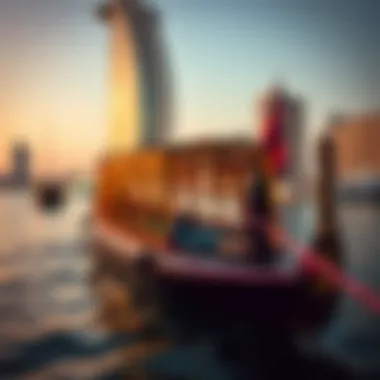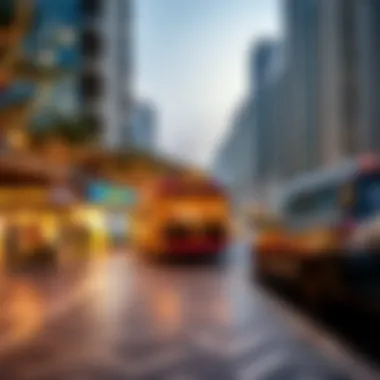Understanding Abra Dubai Timings and Their Implications


Intro
In the bustling metropolis of Dubai, the winding waterways might not immediately spring to mind as a critical component of its transportation infrastructure. Yet, the Abra boats, those charming wooden vessels, serve as a vital link between the city's varied districts. Understanding their operational timings is not only fascinating but essential for anyone interacting with Dubai's real estate market, tourists navigating their way from one attraction to another, and residents looking for a swift transit option.
Abra boats operate across a myriad of routes, each uniquely tailored to the needs of the communities they serve. Comprehending their schedules—which adjust due to traffic, weather, and seasonal tourism patterns—can enhance one’s experience in the city and even influence investment decisions in the thriving property landscape.
In this exploration, we will dissect the timing of Abra services, evaluate their implications for various stakeholders, and draw connections to the broader real estate trends. This narrative aims to equip you with the knowledge necessary to navigate both the waterways and the complexities of Dubai's housing market seamlessly.
Preface to Abras in Dubai
The Abra boats, traditional wooden vessels, form a vital component of transportation in Dubai. They serve not just as a means to cross the waters of Dubai Creek, but also embody the cultural richness of the city. Understanding the dynamics of Abra operations, especially their timings, is crucial for residents and tourists alike. The operational hours shed light on how accessible this form of transport is to everyone, reflecting on broader transport and urban planning strategies.
Significance of Abras in Dubai's Transportation
Abras play a key role in easing traffic congestion in a city that has seen rapid urban expansion. As major thoroughfares become gridlocked with vehicles, these small boats provide a quick and scenic route across the water, embodying a blend of practicality and charm.
- Convenience: The Abra service offers a simple and effective way for people to navigate between both sides of the creek, cutting travel time significantly compared to road routes.
- Cost-Effective: With a nominal fare, riding an Abra is economically friendly for tourists and residents, allowing for easy access to various parts of the city.
- Cultural Heritage: Beyond mere transportation, Abras link to Dubai's history, emphasizing the city’s maritime roots and promoting tourism.
General Overview of the Abra Experience
Riding an Abra is more than just getting from point A to B. It’s an experience steeped in tradition. As you step onto one of these charming boats, the gentle sway of the water beneath you can feel calming amidst the hustle and bustle of city life. The ride itself offers stunning views of Dubai’s skyline, a contrast between traditional architecture and modern skyscrapers.
- Ambiance: The cool breeze on a hot day adds to the charm, making for a pleasant journey across the creek.
- Community Interaction: Particularly during peak hours, you're likely to share your ride with locals. This communal aspect allows for interactions that reveal cultural insights not found elsewhere.
- Visual Feast: Many riders find themselves reaching for their cameras, as the vistas available onboard are jaw-dropping, showcasing Dubai’s evolution.
Operating Hours of Abras
Operating hours are the lifeblood of any transport service, especially in a bustling city like Dubai. The timing of Abras doesn’t just dictate when residents and tourists can embark on their short journeys across the waterways; it also serves as a critical indicator of the service's overall accessibility, reliability, and relevance to the city's infrastructure. Understanding these timings helps potential riders plan their trips efficiently, ensuring they can make the most of their time without unnecessary hassle.
Regular Timings of Abras
Typically, Abras operate from early morning until midnight, offering rides every 15 to 20 minutes. The exact timing may vary based on specific routes and whether it's a weekday or weekend. For instance, an Abra crossing may commence operations at 5:30 AM, making it particularly convenient for early risers who need to commute for work or other obligations.
It's beneficial for anyone planning to use the service often to familiarize themselves with its normal hours. This insight allows residents and tourists to avoid during periods when trips might be crowded, ensuring a smoother ride. Regular operation hours provide a framework that enhances the overall experience of water transportation in Dubai.
Peak Hours and Their Impact
Riding an Abra during peak hours can resemble a rat race, where commuters jostle to secure a spot on the small wooden vessels. Typically, the morning rush—around 7:30 AM to 9 AM—and the evening rush—between 5 PM and 7 PM—see Abras packed to the brim.
This spiking demand indicates the service's relevance for daily commuting and how it plays a pivotal role in Dubai’s transportation ecosystem. Given that these boats are a preferred transport mode for many locals, heavy traffic at peak times could lead to waiting times, particularly during weekdays. Understanding these peak hours serves as a heads-up for tourists, allowing them to plan their journeys strategically if they wish to delve into the authentic Abra experience.
Changes in Timings During Special Events
Dubai is a city where celebrations abound, so Abra services may see adjusted timings during large events or public holidays. For example, during the Dubai Shopping Festival or New Year's celebrations, operating hours may extend to accommodate the influx of revelers. Similarly, important Islamic holidays like Eid often lead to unique schedules, affecting both frequency and operation hours.
Events such as the Dubai Marina Fireworks or cultural festivals can transform the waterways into perpetual buzz zones. To make the most of such occasions, it’s crucial that riders stay informed about any schedule modifications that might arise. Checking local announcements or updates on social media platforms can be a game changer when planning a night out or a special occasion alongside the water.
In summary, grasping the operating hours of Abras is pivotal not only for enjoyment and convenience but also for smart planning, particularly for those considering property investments near these waterways. As dynamics shift throughout the week or across seasons, a keen awareness of scheduling nuances can enrich one’s experience with this iconic aspect of Dubai's heritage.


Factors Influencing Abra Timings
Understanding the factors that influence Abra timings is crucial for anyone who relies on these traditional water taxis for their daily commute or leisure activities in Dubai. The Abrah, with their unique charm and convenience, can be affected by various factors such as weather conditions and regulatory guidelines.
Weather Conditions and Their Effects
Weather plays a significant role in the operations of Abras. Extreme heat, rain, or windy conditions can affect not just the safety of the operations but also the demand for rides. For instance, during the scorching summer months, many riders avoid daytime trips, opting instead for early mornings or late evenings when it's more bearable. On the other hand, rain may lead to fewer riders as well since the open-air nature of these vessels provides little shelter.
Moreover, strong winds can create rough waters, making it unsafe for Abras to navigate. In such cases, operators might need to suspend services temporarily. This can lead to delays and extended wait times for riders hoping to catch a boat. Thus, anyone planning to use this service should keep a keen eye on weather updates, as it directly impacts the accessibility and timing of the rides.
Regulatory Guidelines Impacting Operations
Like any mode of transportation, Abras are subject to various regulatory guidelines set forth by local authorities. These protocols ensure the safety and reliability of the service. For instance, Dubai's Roads and Transport Authority (RTA) maintains strict operational guidelines that cover everything from the licensing of boat operators to the permissible number of passengers per journey.
Any changes in these regulations or their enforcement can lead to fluctuations in operational hours or availability. It is essential for riders to stay informed about these guidelines, especially during holiday seasons or special events when operators might adjust their schedules to accommodate increased demand. Failure to do so can result in missed rides or lengthy wait times.
Seasonal Variations in Abra Operations
Understanding how seasonal variations affect Abra operations in Dubai is crucial for anyone using or considering this form of transportation. Different times of the year bring shifts in demand, passenger volumes, and timing of service, all linked to significant events like tourism seasons or Ramadan. Each of these factors holds implications not just for riders, but also for those interested in investment opportunities around Abu Dhabi’s waterways.
Impact of Tourism Seasons on Timings
During peak tourism seasons, which primarily run from October to April, more travelers flock to Dubai. This influx results in increased demand for Abra services, leading to adjustments in operational hours. Abras may extend service hours or increase the frequency of trips to accommodate the heightened activity. Visitors frequently seek authentic experiences, and riding an Abra provides just that.
- Increased Operations: Expect more Abras to be operational,
- Longer Wait Times: With increased passengers can also come longer waiting times, especially around major attractions like Dubai Creek.
Understanding these trends helps both tourists and expats plan their trips effectively. For instance, timing a ride early in the morning or later in the evening might offer a more tranquil experience.
Ramadan and Its Unique Timetable Adjustments
Ramadan, a significant month in the Islamic calendar, presents unique adjustments in Abra scheduling. During this time, operating hours generally shift to align with the fasting schedule. Services may start later in the day and run longer into the night. This alteration allows riders to enjoy the experience post-iftar, as many seek leisure activities after breaking their fast.
"Adjusting Abra schedules during Ramadan not only caters to the needs of riders but also reflects a rich cultural sensitivity within the transportation framework."
It's essential for passengers to be aware of these changes to avoid inconvenience. Riders might find that some routes have limited schedules or reduced frequency during daylight hours, making night rides more appealing.
Epilogue
To wrap it all up, seasonal variations in Abra operations bring about essential considerations for riders and investors alike. Whether it’s the buzz of tourism peaks or the respectful adjustments during Ramadan, staying informed about these nuances allows for a smarter experience navigating Dubai’s waterways.
Practical Considerations for Riders
When it comes to riding an Abra in Dubai, understanding the practical considerations can enhance the overall experience. A good ride can depend on various factors, including the time of day, the crowd, and even weather conditions. By keeping these considerations in mind, riders can make the most out of their trips and navigate through the ever-busy waterways of Dubai.
Best Times to Ride in Terms of Experience
Choosing the right time to board an Abra is crucial for maximizing enjoyment. Early morning trips, just after sunrise, offer a peaceful atmosphere where the gentle breeze makes for a refreshing ride. Plus, you get to witness the city waking up—a stunning spectacle that shouldn't be missed.


On weekends, the afternoons tend to be busy with both tourists and locals. If you prefer a more serene experience, early weekends are less crowded. For those looking to capture breathtaking sunset photos, the late afternoon offers fantastic views, turning the waters into a canvas of colors. Alternatively, if you want to avoid crowds, riding during regular work hours, particularly from 10 AM to 3 PM, can be beneficial. This time frame sees fewer people on the Abras.
Navigating Crowds and Wait Times
Crowds can be a significant factor when commuting by Abra. Understanding peak hours helps riders make informed choices. During rush hours—especially during the morning from 7:30 AM to 9:00 AM and evenings from 5:00 PM to 7:00 PM—the lines can be long and the boats packed. It’s almost like a rush hour on the roads, but on the water.
Here are some tips for managing crowd-related concerns:
- Plan Ahead: If you know you need to cross the creek at a busy time, maybe leave a bit earlier. This way, you can catch a boat without the hassle.
- Consider Alternative Routes: If one station seems too crowded, look for another nearby station. You might save time and also get a different view of the city.
- Observe Social Distancing: At peak times, be mindful of personal space as much as possible. Respect for others' privacy can create a more pleasant environment for everyone.
"Time your ride well, and it can be a breeze. Get it wrong, and you might find yourself in a sea of stress instead of sipping in the sights."
Ultimately, knowing when to ride and maneuvering through crowds can transform a simple commute into a significant part of your Dubain journey, creating memories that last a lifetime. Those who take this into account will not only get where they need to go but will also appreciate the journey along the way.
For more information on riding Abras, check out Dubai's official tourism website.
Explore community experiences at platforms like Reddit. Feel the pulse of the city and harness tips from fellow riders.
Implications for Real Estate Investors
Investing in real estate requires a meticulous understanding of the local market dynamics, and in a vibrant city like Dubai, the timing and accessibility of its transportation options can greatly sway market prospects. Abras, the traditional wooden boats, serve as not just a modern commuting option, but as a pivotal aspect influencing both property values and buyer behaviors.
Proximity to Abra Stations as a Property Factor
The proximity of a property to Abra stations can significantly affect its desirability and market value. Access to these stations offers a unique selling point, especially for potential buyers or tenants who prioritize affordability and convenience in daily commuting. When evaluating real estate options, families, expatriates, and even local residents often prefer homes that allow them to seamlessly hop on an Abra and traverse the waterways of Dubai.
Some key considerations include:
- Commuting Ease: Being near an Abra station lessens the hassle of traffic jams, making it attractive to daily commuters.
- Scenic Views: Properties close to the water often carry a premium due to the picturesque views they offer, reinforcing their real estate value.
- Cultural Appeal: For tourists and new residents, living near Abras adds a local character to their experience.
From a practical standpoint, data shows that neighborhoods within walking distance of these Abra stations often witness a more robust demand, leading to increased rental rates and rising property values. Investing in such areas could yield favorable returns for real estate investors looking to capitalize on accessibility trends.
Market Trends Reflective of Abra Accessibility
Understanding market trends related to Abra accessibility illuminates several vital factors that affect property values and investment opportunities.
- Rising Popularity of Waterway Transport: As more people look for alternatives to traditional modes of transport, the demand for properties near waterway access has surged. Traditional values regarding urban living are shifting towards acknowledging the benefits of integrated transport networks.
- Real-Time Data from Commuting Patterns: Reports indicate fluctuating demographics affecting the availability and value of real estate. Areas seeing increased commuter traffic via Abras often correlate with rising interest from developers and investors, enhancing property attractiveness.
- Connection with Major Development Plans: The local government's urban planning initiatives reveal a clear inclination toward enhancing waterway transport routes. Properties adjacent to these transport enhancements can anticipate future appreciation in value, driven by improved accessibility and connectivity.
By analyzing these trends, investors can make informed decisions about their investments, aligning them with the ongoing evolution of transport needs in Dubai.
"Investing in properties near Abra stations isn't just about location; it's about anticipating the future demand shaped by the evolving urban landscape."
In essence, understanding the implications of Abra Dubai timings on real estate investments can guide potential buyers and developers towards maximizing their value in the dynamic Dubai market. Recognizing the importance of transport accessibility can help stakeholders remain astute in their decisions.
Comparative Analysis with Other Transportation Modes
Abras as a Distinct Experience Compared to Taxis and Buses


When it comes to navigating the bustling streets of Dubai, the Abra system stands out as a unique option. Unlike taxis, which can often get caught in traffic jams, or buses that run on fixed schedules and routes, Abras provide a more fluid experience. Riding an Abra allows you to glide across the water, offering picturesque views of the city’s skyline. You might find that instead of the usual honks and the smell of exhaust, there’s the gentle lapping of water and the refreshing breeze that comes with being on the water. This distinctive experience fosters a sense of connection with the city that other transport modes often lack.
From a practical standpoint, affordability is a major aspect. A typical Abra ride costs only a few dirhams, providing a cost-effective journey. This is especially beneficial for budget travelers looking to stretch their dirhams a bit further. Meanwhile, a taxi fare can quickly add up, particularly during peak hours.
"Riding an Abra is like taking a small holiday in the middle of your daily commute."
However, accessibility is a consideration. While taxis and buses can pick you up at various locations throughout the city, Abras are primarily stationed at designated docks near the waterfront. Thus, if you're far from these docks, time spent traveling to them may outweigh the benefits.
Biking and Walking in Relation to Abra Usage
Biking and walking are two more modes of transportation worth discussing in relation to Abras. While they might serve a different purpose, they complement each other quite well. Biking is an excellent option for those who want to take in the sights at a more leisurely pace. Dubai has invested in cycling paths, making it easier and safer for cyclists, especially along the waterfront. However, biking can wear you down in the sweltering heat, which in less favorable conditions might not be as pleasant. On the other hand, when you hop on an Abra, not only do you skip the sweat, but you also gain a scenic perspective of Dubai that’s hard to replicate on land.
Walking is another viable option, particularly in areas like Dubai Marina or the Creek, where attractions are closely situated. Still, there's a limit to how much distance one can cover by foot, especially with the sun beating down. Here’s where a quick Abra ride can be a real time-saver, as you can shift from one side of the waterway to the other in mere minutes.
Both biking and walking are great for absorbing the atmosphere and interactions with local communities, yet indeed they lack the refreshing nature of a waterway travel. In essence, each transport mode can enhance the other, touting efficiency while giving the rider various flavors of the city.
Cultural Context of Abras in Dubai
The Abra boats of Dubai are more than just vessels traversing the waters; they are a living testament to the city's rich culture and history. Understanding the cultural context of Abras helps unearth their significance in the modern landscape of Dubai. This section will explore how these traditional boats are woven into the fabric of daily life in the city, serving not only as means of transportation but also as symbols of heritage and connection to the past.
Historical Significance of Abras
Chronicles tell us that Abras have been navigating Dubai Creek for well over a century. Originally, these wooden boats were the primary transport for goods and people across the waterway. They played a pivotal role in connecting the different regions of what was then a small fishing village, enhancing trade and facilitating communication. Today, they hold a nostalgic value that resonates with both Emiratis and expatriates alike.
In the early days, the craftsmanship of Abras demonstrated the skills honed over generations. Each boat was hand-crafted from the best-quality wood, a practice that showcased the artisanal traits of its builders. Tourists and locals, in essence, are not merely boarding a boat; they are stepping onto a piece of history.
"Riding an Abra is like taking a ride through time; it’s the pulse of Dubai's heart - vibrant and beating down the ages."
Cultural Perception of Water Transport in Dubai
Water transport in Dubai carries more than just connotations of mobility; it represents a lifestyle closely linked to the natural resources of the region. The city's evolution from a pearl-diving hub to a modern metropolis is closely tied to its waterways. For many locals, taking an Abra ride is steeped in sentiment. The views of ancient souks, modern skyscrapers, and the calm waters of the creek serve as a visual narrative that illustrates Dubai’s growth.
Furthermore, the Abra functions as a melting pot where people from various walks of life converge. You’ll find tourists snapping photographs alongside local fishermen, which highlights the soft underbelly of community spirit that thrives on this water transport.
In summary, the cultural context surrounding Abras extends beyond mere transportation; it encapsulates a historical journey and encapsulates Dubai's identity. For homebuyers, investors, and developers, recognizing this intrinsic value can influence decisions, offering unique insights into how these waterways are not just passages but also reflections of the cultural nuances that define Dubai.
Closure: The Role of Abras in Dubai's Urban Landscape
The significance of abras in Dubai's urban framework is often understated but profoundly impactful. This water transport system embodies not just a means of getting from point A to point B, but also serves as a symbolic bridge connecting the rich cultural heritage of the Emirate with its modernity. As we look towards the future, it is crucial to comprehend the intricate role that these traditional boats have in shaping the city's transportation ecosystem.
Future Prospects for Abra Services
The future of abra services in Dubai seems poised for growth and innovation. With the swift pace of urban development and increasing numbers of residents and tourists alike, the demand for accessible waterborne transport is set to rise. The Dubai government has already laid out several initiatives targeting enhancements in service efficiency. Infrastructure improvements could include:
- Expansion of docking stations to accommodate larger crowds
- Integration with smart technologies for user convenience, such as real-time tracking
- Sustainable practices to ensure the environmental impact of abras remains minimal through cleaner fuels or alternative energy sources.
These enhancements could make riding abras a more appealing choice compared to terrestrial options, translating to an increase in foot traffic around commercial and residential properties located near waterways. The future may also see an increase in thematic cruises or charter services, catering to the unique cultural experiences tourists seek while navigating the city’s waterways.
Final Thoughts on Abra Timings and Their Impact
As we've journeyed through the various nuances of abra timings, it’s apparent that the scheduling of this water transport is not arbitrary. Timing not only influences the convenience for riders but also impacts the broader dynamics of urban life in Dubai. With peak hours showing increased crowding, understanding these shifts can offer valuable insights for:
- Residential buyers who may wish to invest in properties positioned near abra stations for easier commutes.
- Business owners looking to leverage peak traffic moments for maximizing customer engagement.
The adaptability of abra services amid varied cultural events and seasonal shifts reveals a resilience that mirrors the city itself. With growing awareness and appreciation of local transport modes, the abra system holds a key position in advancing Dubai's overarching transportation strategy, effectively linking communities while cherishing its unique maritime culture. You can explore more on the significance of abra services on sites like Wikipedia and other informative platforms.



